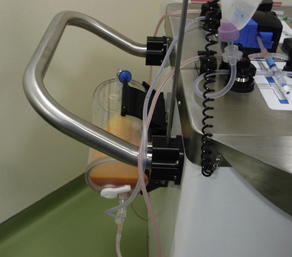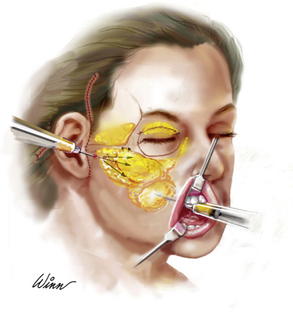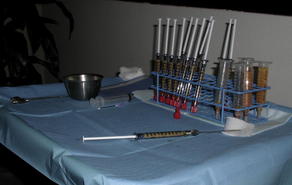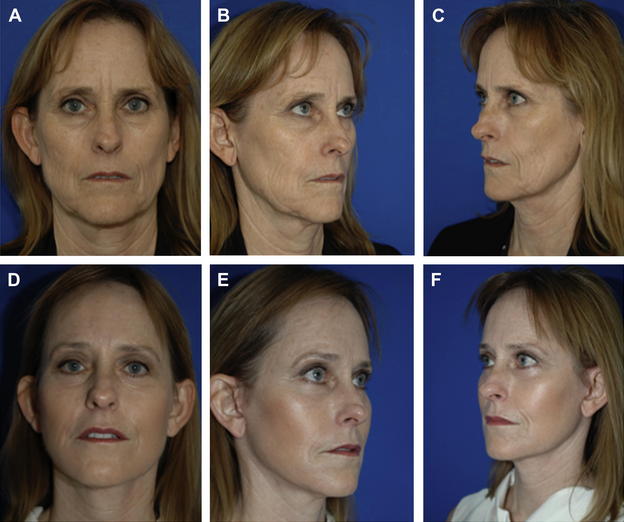Adipocyte-Derived Stem and Regenerative Cells in Facial Rejuvenation
Keywords
• Adipocyte • Stem cells • Regenerative • Facial aging • Fat graft • Revolumization
Overview: nature of the problem
Autologous fat grafting is a minimally invasive technique for multiple applications in facial aesthetic and reconstructive surgery.1–3 Fat has been described as the ideal filler.2 It is biocompatible, versatile, long lasting, and has a natural appearance. Since the first use of fat for soft tissue augmentation in 1893 by Neuber,4 investigators have noted the variable long-term outcomes. In 1950, Peer and colleagues5 histologically evaluated fat grafts and found approximately 45% volume survival at 1 year after implantation. More recent investigators report up to 70% of the initial fat-filling tissue volume being reabsorbed.6,7
Today, fat grafting is part of the plastic surgeon’s repertoire and is considered a primary technique in facial aesthetic, aesthetic breast, and reconstructive surgery.2,8–11 Meticulous technique greatly influences outcomes, as exact attention to detail is crucial.2 A key to optimizing engraftment includes concentrating the fat per unit volume of graft delivered per area of native tissue in the correct proportions. This maximizes the surface area of grafted fat and prevents large clumpy deposits. Other techniques to maximize host tissue surface area and provide maximum nutritional support to the implanted graft include
A recent paradigm shift in facial plastic surgery and breast surgery occurred to include large-volume fat grafting.12,13 The introduction of large-volume grafting provided a new independent option for total facial rejuvenation or breast augmentation. Similar to other descriptions, our preferred techniques have evolved from injection of discrete wrinkles and filling folds to using fat for total facial revolumization; fat is clay in the plastic surgeon’s hands and can be used in virtually any application.
The recent surge in popularity is not the first time that fat has appeared as a natural all-purpose filler.1 For many surgeons, fat has cycled in popularity. Some found fat frustrating to use with extremely variable outcomes causing many to completely abandon the technique.1 However, innovators such as Sydney Coleman and Mel Bircholl persisted in using fat transfer as a primary surgical tool to treat many types of aesthetic and reconstructive cases and developed methods to achieve consistent success.2,3
Recent evidence demonstrating an abundance of stem and regenerative cells in adult human fat, which can be segregated and used for a wide variety of disease conditions, reinvigorated the field of fat grafting.14,15 As with many new technologies and approaches, the use of stem and regenerative cells has been controversial for many reasons, with a lack of properly conducted scientific experiments.16,17 The concept of harnessing our own cells and using them to fight disease or increase blood supply is a complex issue. Further complicating the issue, many have muddied the waters by publicizing the miracle of stem cell facelifts or breast augmentation. At present, the authors cannot validate the exact contribution of adding stem and regenerative cells to traditional fat grafting in relation to final outcomes.
As clinical applications using adipose-derived regenerative cells (ADRC) have been increasingly reported, there has been valid skepticism and concern about the true additive value of combining additional stem and regenerative cells with fat for use in plastic surgery. Fat alone may be sufficient as a vehicle to transports cells and the addition of ADRCs may do little to help the graft or regenerate tissues. To address concerns, the American Society of Plastic Surgeons and the American Society for Aesthetic Plastic Surgery published a joint position statement concerning stem cells.18–20 They concluded that scientific evidence was limited with regard to both safety and efficacy. At present, it is still unknown if increasing the concentration of stem cells further amplifies the effects of traditional fat grafting. However, early indications in clinical trials21,22 do show a tendency for increased fat survival with increased ADRC counts.21,22 There is increasing anecdotal evidence that ADRCs perform best in hostile environments, such as radiation wounds, burns, and ischemia.
Indications for therapeutic options
Applications for ADRC regenerative therapy are organized into 2 areas20:
Specific indications and clinical uses in plastic surgery range from aesthetics using cell-enriched fat transfer (CEFT) for facial rejuvenation and breast augmentation to reconstructive surgery with wound healing in chronic and radiated wounds. Other specialties, including regenerative medicine applications, consist of potential uses in many disparate fields of medicine including inflammatory bowel disease, diabetes, chronic obstructive pulmonary disease (COPD), neurologic disorders (eg, Parkinson disease, multiple sclerosis, stroke, and others), and cardiac myocyte or urothelial cell regeneration, to name a few.11,13,23,24 A recent review published in June 2011 reported 18 ongoing clinical trials on the use of ADRCs in regenerative medicine.23,25 One year later in July 2012, a search on www.clinical-trials.gov for open recruiting studies with the term “adipose-derived stem cells” or “adipose-derived regenerative cells” revealed 27 trials that were actively recruiting.
Despite intense interest, there are many questions regarding the use of ADRCs in plastic surgery. Foremost, we need to know about safety. Initial studies, including the RESTORE-2 trial have demonstrated no difference in complications using cell-enriched fat versus traditional fat grafting.26 Other reports in the literature or various commentaries have raised concerns with oncologic safety. However, to date we are unaware of any proven oncologic risk.20 Equally important, it needs to be determined if stem cells make a true clinical difference and, if so, under what conditions? For instance, it seems ADRCs and cell-enriched fat work best in hostile environments such as radiation wounds and ischemia.23 However, are soft tissue benefits also observed in healthy tissue when used for facial aging? Is photodamage a reversible ischemic condition induced by capillary loss and replenished by stem cells? Do ADRCs have an effect on elastin regeneration or on apoptosis? Do ADRCs regenerate tissue and increase the survival of fat grafts? Are ADRCs an amplifier for fat grafting? Are there conditions that could be treated solely with ADRCs? What might they be? The purpose of this article is to review traditional fat grafting methods and the use of fat as clay to refine the results of aesthetic and reconstructive surgery, and discuss the rationale and potential applications of adipocyte-derived stem and regenerative cells in facial surgery.
Therapeutic options
Traditional Fat Grafting Techniques
The goal of lipoharvesting is to collect small parcels of adipose tissue and/or adipose cell clusters without disturbing cell viability. Each step of the fat grafting process should be optimized. Harvesting, processing, delivery, and storage should each be evaluated on their own merits. Even then, the host and the effect of the host environment are critical determinants of success in traditional fat grafting. Once the fat has been harvested, processing is aimed at creating the purest graft possible by clearing the harvest of blood and tumescent fluid with minimal damage to fat tissue (Fig. 1). It is also important to control graft hydration because the residual graft fluid will be a factor when calculating the volume to be grafted resulting in less graft material delivered per unit volume. Fat grafting must minimize inflammation and promote healing. The presence of blood, fatty acids, and other debris is believed to stimulate an inflammatory response and contribute to graft degradation.2,3,8 Current methods of processing include centrifugation, decanting, straining, and filtration.27 Centrifugation is the most common, but may not necessarily be the best technique. Adipocytes may be damaged by exposure to the open air; 50% cell lysis has been shown.28,29 There are also volume/time limitations. Home-brew approaches, cheesecloth, hand cranks, float, and pluck are highly variable. Most of these are open systems and are not easily performed in a sterile field. Tissue filtration to process fat is performed in a closed system within the sterile field. It results in the least extraneous graft material and allows the user to adjust graft hydration. Decanting the fat or gravity drainage has many advocates, but does not eliminate lipid or inflammatory cells or other systems.
Delivery is performed via a Byron cannula attached to a Celbrush. The Celbrush permits small threads of fat graft to be deposited in a retrograde fashion (Fig. 2). For facial fat grafting, an 18-gauge needle is used to make a needle puncture in key areas such as the temporal region and lateral eyebrow, the malar region, the upper and lower eyelid, the nasolabial fold, the marionette basin, the labiomental groove, the prejowl region, the lips, the buccal fat pad, and the mandibular border (Fig. 3). During facelift surgery, the skin and Superficial muscular aponeurotic system (SMAS) are elevated and a transbuccal approach can be used for fat transfer. The range of total amount of fat grafted is from about 20 mL to 200 mL in the face at a single setting.
For many surgeons, the Coleman technique of structural fat grafting, which involves centrifugation, placement of microdroplet grafts delivered by a retrograde injection technique, remains the gold standard (Fig. 4.).30 Other techniques that permit larger volumes of fat to be processed such as bilaminar filtration, which shows a reduction in lipid content and inflammatory cells with excellent control of the degree of hydration, may evolve to be techniques of choice.
CEFT
Since the identification of ADRCs in fat tissue,14 many scientists and surgeons have begun to use these cells to supplement or enrich fat grafts.17 In addition to their ability to undergo multipotent differentiation, ADRCs have been shown in vitro to express and secrete growth factors, cytokines, chemokines, and extracellular matrix molecules that are important for neovascularization, regulation of apoptosis, modulation of immune response, and extracellular matrix remodeling, and even chemokines responsible for recruitment of endogenous stem and regenerative cells.31
As preclinical studies of ADRCs were performed, 2 important aspects were found. First, the host environment seemed to be an important determinant of the behavior and effectiveness of ADRCs.31 Second, the capacity of stem cells to develop in the host tissue into which they were introduced has little correlation with the functional improvement observed.31
ADRCs are the nonbuoyant cellular fraction derived from enzymatic digestion of adipose tissue, and include ADRCs, preadipocytes, and vessel-forming cells. It is believed that ADRCs contribute to graft survival by directly or indirectly aiding in vascularization of the graft. Preclinical work indicates improved graft survival and quality with the addition of ADRCs.22,32 Early clinical work has not yet formally documented improved long-term graft survival. In breast surgery, ADRCs combined with fat grafting have demonstrated a low incidence of calcification and radiologic abnormalities.33,34 Recently published studies found that cell-enriched fat grafts had better retention and more normal histology compared with traditional fat grafts.34,35 Yoshimura and colleagues36 found cell-enriched fat grafting for breast augmentation to be superior to the conventional techniques they had previously used.37 Other workers in the field such as Delay and Khouri have had similar outcomes with conventional fat grafting. We have positive anecdotal experiences combining CEFT with surgical rejuvenation procedures (Fig. 5). This combination has become a preferred technique for us when treating patients with severe effects of photodamage.
Stay updated, free articles. Join our Telegram channel

Full access? Get Clinical Tree













